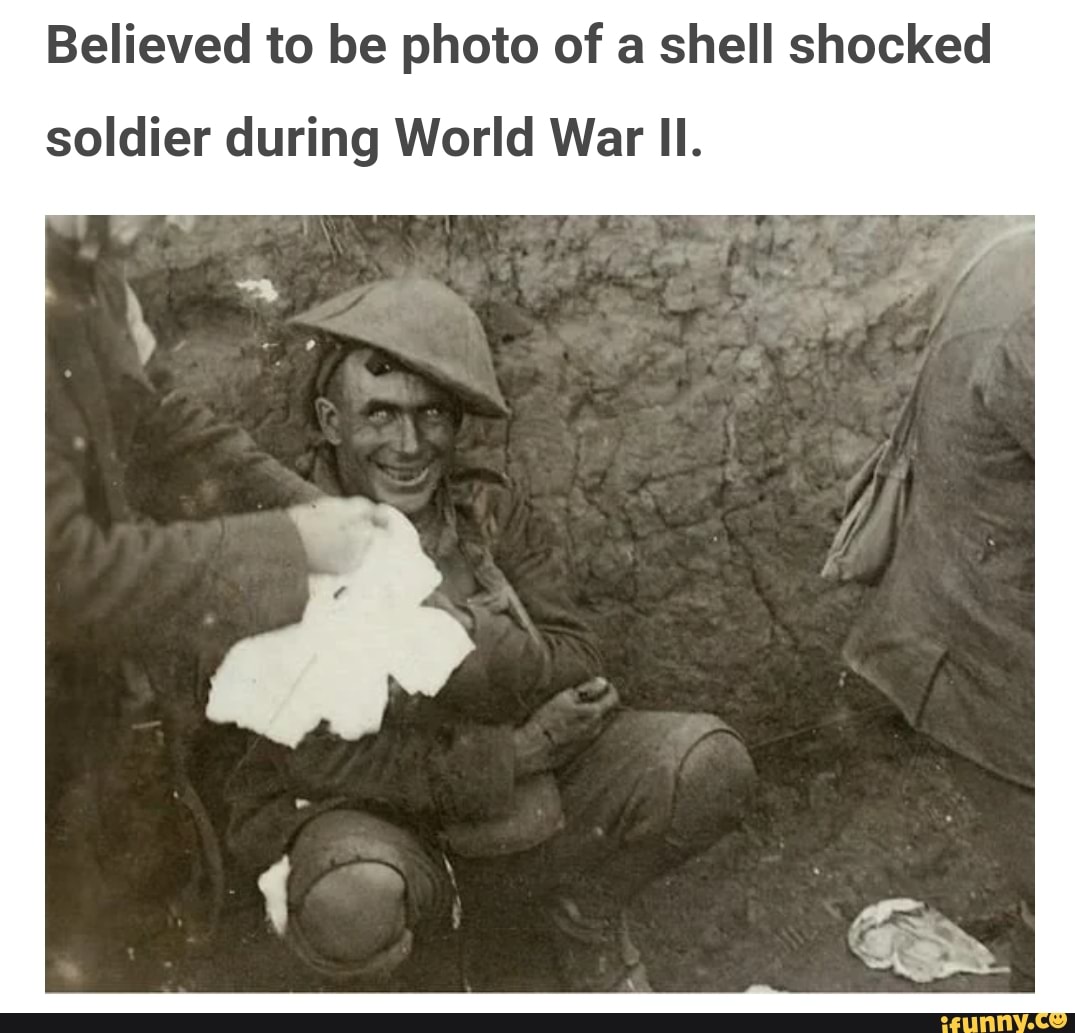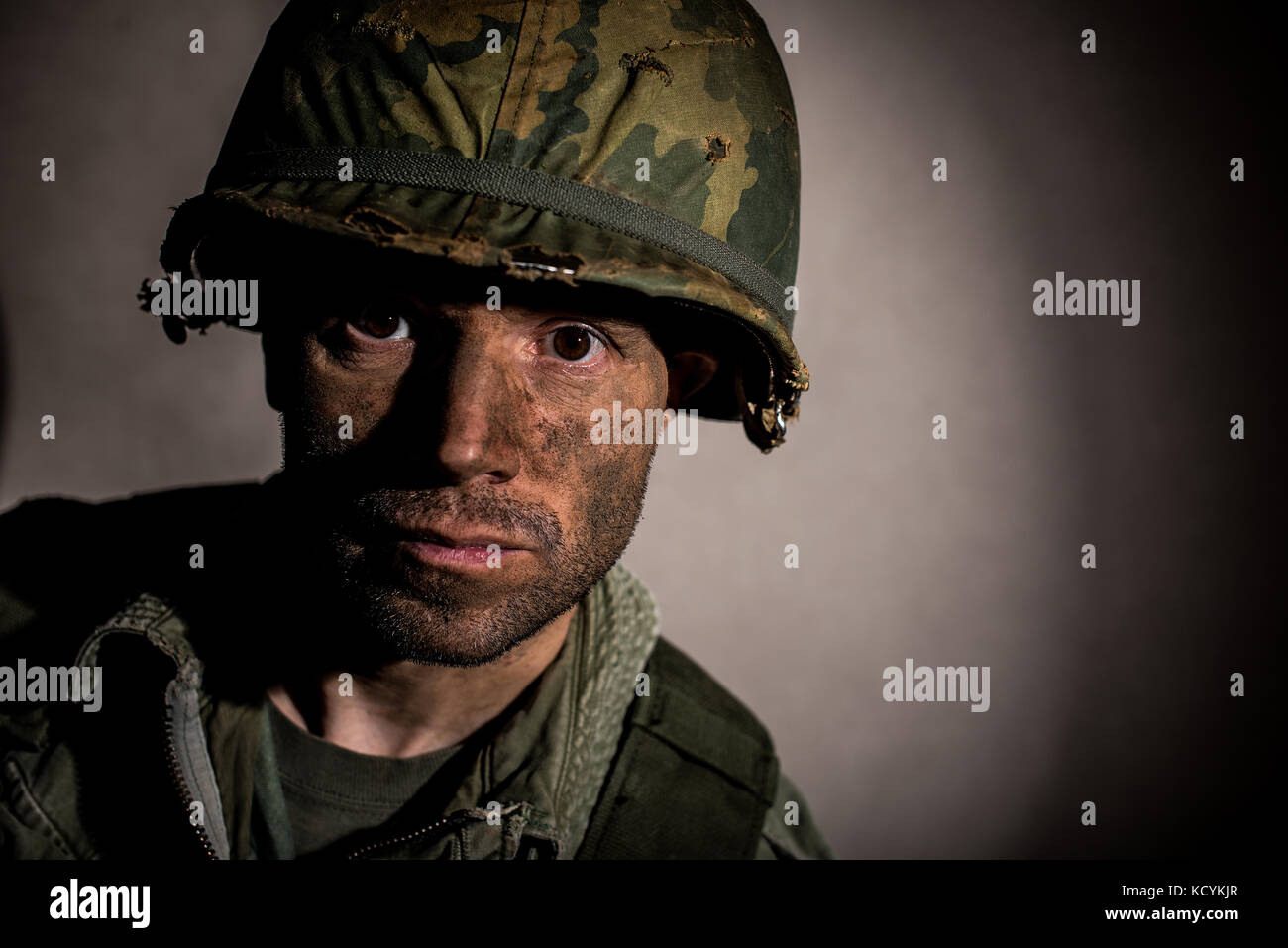The "1000 Yard Stare" Meme: From WWII Trauma To Viral Trend
Does a single image possess the power to encapsulate the profound trauma of war and its lasting impact on the human psyche? The "Thousand Yard Stare" meme, born from a haunting painting, has evolved into a potent cultural symbol, sparking conversations about mental health, historical accuracy, and the pervasive influence of the internet.
The genesis of this cultural touchstone lies in a painting titled "2,000 Yard Stare," a 1944 portrait by American artist Thomas Lea. This artwork depicts a nameless marine, his gaze lost and vacant, a chilling representation of the psychological toll of the Battle of Peleliu during World War II. The painting, now housed at the United States Army Center of Military History in Fort Lesley J., serves as the primary visual anchor for the meme.
The meme's journey, originating on platforms like Reddit around 2014, saw it explode across various social media channels, including TikTok. It utilizes the imagery to convey a range of emotions, from profound sadness and disillusionment to ironic commentary on everyday situations. The "Thousand Yard Stare" is an exploitable, a reaction image that transcends its original context to resonate with a broad audience. Its power lies in its versatility: the image can be applied to almost any context where a sense of detachment, exhaustion, or trauma is relevant.
The painting, now a cultural icon, wasn't simply a snapshot of a moment, it was the culmination of countless battles, a symbol of the horrors of World War II and the battle of Peleliu. This specific battle itself was brutal, with soldiers facing intense combat, heat, and disease. Many were forever changed by their experiences. The subject of the painting embodies the psychological impact of war. It's an important reminder that even in the midst of humor, the meme taps into the serious psychological condition of war.
| Category | Details |
|---|---|
| Meme Origin | "Thousand Yard Stare" / "2,000 Yard Stare" |
| Artist | Thomas Lea |
| Painting Creation Year | 1944 |
| Original Context | Battle of Peleliu, World War II |
| Subject | Nameless Marine |
| Key Themes | Trauma, Shell Shock, PTSD, War's Psychological Impact |
| Initial Usage | Reaction images, expressing feelings of detachment or exhaustion |
| Meme Evolution | Adaptation and reuse across various online platforms (Reddit, TikTok, etc.) |
| Current Usage | Humor, social commentary, exploration of mental health, historical events. |
| Historical Accuracy | While the meme often portrays the trauma of war, some accounts regarding the origin may be fictionalized. |
| Authentic Website | U.S. Army Official Website |
The rise of the "Thousand Yard Stare" meme highlights a complex interplay between historical context and online culture. The image of the soldier, forever etched in the viewer's mind, becomes a vehicle for commentary on a range of experiences. Whether referencing the exhaustion of a long work week, the feeling of being overwhelmed by current events, or the more serious and poignant themes of the painting, the meme transcends its simple visual nature to spark dialogue.
The "Thousand Yard Stare" meme is not alone; it is part of a broader trend of war-related memes. Consider the iconic photo of a soldier laughing in the trenches during World War I, which can be seen as a symptom of shell shock, or PTSD. This, and other similar memes, create an ironic contrast between the horrors of war and the humorous adaptation on the internet. Like the "Thousand Yard Stare," these images invite viewers to reflect on the complicated connection between comedy and trauma.
It's crucial to examine how memes affect public understanding of significant events and the potential for misinformation to spread. For instance, some stories about the image of the soldier's "Thousand Yard Stare" may be apocryphal, underscoring the need for responsible internet usage. Nonetheless, memes can also act as educational instruments, initiating discussions about the impact of war on society and promoting a greater understanding of shell shock and PTSD. They can humanize historical events, making complex topics more approachable.
Shell shock, initially misunderstood, has been increasingly recognized as a genuine medical condition. The condition was often dismissed as cowardice, but modern studies now directly connect it with PTSD, a condition affecting millions worldwide. The "Thousand Yard Stare" meme, therefore, becomes a symbol not just of war, but of the invisible wounds that war inflicts.
The memes evolution also highlights a common trend: the way internet content develops. From serious commentary to everyday humor, the "Thousand Yard Stare" meme has adapted and transformed, gaining traction on different platforms. Like many things online, the "shellshocked soldier" meme hasn't remained static. It has grown, changed and evolved, reflecting the shifting trends and cultural understandings.
In many cases, animated meme templates, like the party parrot or other animated GIFS, emerge when people create or share a unique style of digital storytelling, adding another layer of creativity. Users can also create and upload their own animated templates using various tools.
The enduring popularity of the "Thousand Yard Stare" meme, and the broader shell shock soldier meme, demonstrates its powerful influence. It taps into the universal experiences of trauma and detachment, but also carries the risk of trivializing a genuine medical issue. The future of the shell shock soldier meme, like all internet trends, remains uncertain, but its impact on the internet's cultural landscape is sure to continue.
The memes continued usage emphasizes the critical role of media literacy. It challenges users to critically examine the sources of images and to be aware of the message behind the content. Users must be able to distinguish between reality and internet-generated content in a society saturated with memes and other online trends. This helps to ensure that the images are not used to reinforce negative stereotypes or promote harmful messages.
The shell shock soldier meme, which is sometimes used with humor, reminds us to remember the psychological condition it represents. It promotes conversations on mental health, the impact of war, and the importance of empathy in a world where we are surrounded by complex issues.
It is important to remember that while the meme might offer lightheartedness, it is also crucial to acknowledge the weight of the original subject matter. The Thousand Yard Stare is a symbol of the trauma that comes with the impact of war. It is a call to recognize those who suffer, even when separated by time or place.
The soldier shell shock memes persistence as a cultural phenomenon underlines its strong resonance with audiences globally. It is much more than a series of pictures; it symbolizes the ongoing effect of the battles faced by individuals and societies. By understanding both its origins and its evolution, people can better appreciate the complexities of the image and its capacity to shape our shared understanding of history, trauma, and the human experience.


